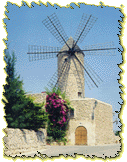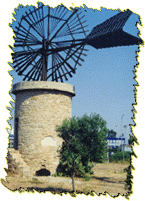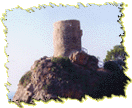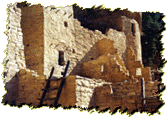
The devastating earthquake that struck the Italian town of Assisi in the
fall of '97 and the damage it did to the region's historic buildings
reminded us of how vulnerable some of our greatest architectural treasures
can be. Among the organizations that rushed to Assisi's aid was the
American Express-backed World Monuments Fund, an international conservation
group that helps to preserve sites of cultural significance worldwide. Each
year World Monuments compiles a list of the world's 100 most endangered
sites. The Savvy Traveler's Tom Verde had occasion to visit one or two, and
has this report.
World Monuments Fund
by Tom Verde
 It's hard to imagine the Spanish countryside, and not picture its
windmills. These romantic structures with their conical roofs and canvas
sails have been cultural icons ever since Miguel de Cervantes immortalized
them in his epic novel, Don Quixote de La Mancha.
It's hard to imagine the Spanish countryside, and not picture its
windmills. These romantic structures with their conical roofs and canvas
sails have been cultural icons ever since Miguel de Cervantes immortalized
them in his epic novel, Don Quixote de La Mancha.
But while Don Quixote looked upon windmills and saw giants, Don Bernardo
Rabasa sees them as a vanishing national treasure.
Rabasa is president of The Friends of the Windmills Association, an
activist group dedicated to the restoration and preservation of antique
windmills on the Mediterranean island of Mallorca, 150 miles off the
Spainsh mainland. Rabasa says that so far his group has identified and
catalogued the remains of close to 900 molinos, or windmills, which were
placed on the World Monuments Fund list of endangered sites a year ago.
 Heavy chains inside the mills regulate the speed and direction of the sails
which can move hard and fast enough to kill a man. There are two types of
windmills on Mallorca: square buildings topped by pinwheels that pump
water and classic flour mills, round stone towers, some dating back
to the 14th century, with revolving roofs and six sails as opposed to the
usual four, a unique feature of Mallorca's molinos. Lack of use, and
therefore lack of maintenance have led to the deterioration of many of
Mallorca's windmills. But in the past two years, Rabasa's group has managed
to raise enough public and private funds to preserve some 50 water mills as
well as four flour mills.
Heavy chains inside the mills regulate the speed and direction of the sails
which can move hard and fast enough to kill a man. There are two types of
windmills on Mallorca: square buildings topped by pinwheels that pump
water and classic flour mills, round stone towers, some dating back
to the 14th century, with revolving roofs and six sails as opposed to the
usual four, a unique feature of Mallorca's molinos. Lack of use, and
therefore lack of maintenance have led to the deterioration of many of
Mallorca's windmills. But in the past two years, Rabasa's group has managed
to raise enough public and private funds to preserve some 50 water mills as
well as four flour mills.
 A $50,000 grant from the World Monuments Fund, says Rabasa, will be used to
restore a prominent windmill overlooking the Bay of Palma, Mallorca's
capital city. Another dream is to open a museum in one of the restored
flour mills dedicated to the history of Mallorca's windmills. For that to
happen, says Rabasa, the group will have to raise at least another
$350,000. Yet should they succeed, many feel that the new breed of cultural
tourists, those interested in more than Mallorca's famous sand and surf,
could provide continued support.
A $50,000 grant from the World Monuments Fund, says Rabasa, will be used to
restore a prominent windmill overlooking the Bay of Palma, Mallorca's
capital city. Another dream is to open a museum in one of the restored
flour mills dedicated to the history of Mallorca's windmills. For that to
happen, says Rabasa, the group will have to raise at least another
$350,000. Yet should they succeed, many feel that the new breed of cultural
tourists, those interested in more than Mallorca's famous sand and surf,
could provide continued support.
Drawing crowds has never been a problem at Mesa Verde National Park in
southwest Colorado, another site on the World Monuments endangered list.
Nearly three-quarters of a million tourists flock here every year to visit
the park's 800-year-old Native American cliff dwellings. Mesa Verde is one
of about a dozen U.S. monuments on the list. Others include San
Franciso's Golden Gate Park and New York harbor's Ellis Island.
Ancient pueblo Indians used sandstone and mortar to create these
impressive, apartment-like complexes in alcoves hundreds of feet above the
canyon floor, for reasons that still elude historians. Some, like the
150-room Cliff Palace, resemble small cities, with towers, alleyways,
courtyards, and ceremonial spaces.
Though not all of them inhabited the cliffs, a population of around 5000
people thrived here during what was the Middle Ages in western Europe,
growing corn, beans and squash on the mesa tops and hunting for game in the
canyons. Then, around A.D. 1300, they abandoned their cliffside homes,
again for reasons that remain a mystery, although many theorize it was
because of drought.They migrated south to the four corners region, where
Colorado, Utah, Arizona and New Mexico meet and where many of their
descendents, the Hopi, Zuni and other tribes, still live today.
 The cliff dwellings lay silent for 600 years, undisturbed by local Ute
Indians who considered it bad medicine to go there. Then, one snowy
December day in 1888, a couple of cowboys searching for lost cattle
were amazed to stumble upon the ruins of Cliff Palace. Twenty years
later, Mesa Verde was declared a national park. At 52,000 acres, it's
the largest archeological preserve in the United States.
The cliff dwellings lay silent for 600 years, undisturbed by local Ute
Indians who considered it bad medicine to go there. Then, one snowy
December day in 1888, a couple of cowboys searching for lost cattle
were amazed to stumble upon the ruins of Cliff Palace. Twenty years
later, Mesa Verde was declared a national park. At 52,000 acres, it's
the largest archeological preserve in the United States.
To reduce the impact of visitors, park officials have limited access to the
dwellings in recent years. However, it's nature that poses a greater threat
to Mesa Verde. Archaeologist Linda Towle is the park's chief of research.
Towle: The very bottom row of stones that is dark, dark red and white,
that's where we have moisture seeping in, probably just from the back of
the alcove. It's sort of a perennial problem. Once the stones are soft and
the mortar starts to erode, and they're on the bottom, then the wall's
gonna fall down.
Towle says it's a testament to the ingenuity and skill of the people who
built these dwellings that they're still standing at all after 800 years,
yet she's not surprised that they're deteriorating.
Towle: They were maintained by the occupants, the same way that you would
fix your roof if it had a leak, the same way that you would fix your storm
windows. They would go in regularly and replace the mortar and replace the
plaster, and if a beam was rotting out they would put in a new beam.
Some attempts to stabilize the walls over the years have succeeded. Others
have resulted in even more damage. The most recent campaign involves
documenting of every square inch of the more prominent ruins and making
repairs with plaster similar in composition to the original. But this
program requires money and the park is short of funds and manpower.
Fifty thousand dollars from the World Monuments Fund, together with grants
from other sources, has provided some relief but park officials say ongoing
support is needed to maintain the historic buildings here.
 Yet short of sending a check, the World Monuments Fund recommends other
ways tourists can help preserve Mesa Verde, Mallorca's windmills and the
dozens of other architectural treasures on the list. Fewer visitors, of
course, would help take some of the pressure off...and by making the
effort to see less popular sites off the beaten path, so-called responsible
tourists actually have the opportunity to see and do more on their
vacations, while at the same time leaving less of a footprint behind.
Yet short of sending a check, the World Monuments Fund recommends other
ways tourists can help preserve Mesa Verde, Mallorca's windmills and the
dozens of other architectural treasures on the list. Fewer visitors, of
course, would help take some of the pressure off...and by making the
effort to see less popular sites off the beaten path, so-called responsible
tourists actually have the opportunity to see and do more on their
vacations, while at the same time leaving less of a footprint behind.
At Mesa Verde National Park in Colorado, I'm Tom Verde for The Savvy Traveler.
For More Information:
For more information on how to make individual contributions, becoming a
member or corporate sponsor of The World Monuments Fund, and to see the
list of 100 endangered places, visit their web site at
http://www.worldmonuments.org/, or call or write them at:
World Monuments Fund
949 Park Avenue
New York, N.Y. 10028
(212) 517-9367
fax: (212) 517-9494
e-mail: wmf@wmf.org
Information on Mallorca:
For more information on Mallorca's windmills or to send donations, contact:
Bernardo Rabasa Oliver
Association de Amigos de los molinos de Mallorca
C/. San Jamie, no. 15
07012 Palma de Mallorca
Spain
tel: 34-71-715095
fax: 34-71-716073
World Monuments Fund in Spain:
Juan Carlos Fierro
President
World Monuments Fund España
Nuñez de Balboa, 83
Madrid, 28006
tel: 34-1-577-7042
For information on Mallorca and visiting Spain, contact the TOURIST OFFICE
OF SPAIN at 1-888-OK SPAIN or visit their web page at http://www.okspain.org
Transatlantic and domestic air transportation courtesy of IBERIA AIRLINES.
For tickets, reservations and information contact 1-800-772 4642 or visit
their web page at http://www.iberia.com
Transportation on Mallorca courtesy of AUTO EUROPE, (800) 223-5555.
Worldwide car rental services at competitive rates. Excellent customer
service.
Information on Mesa Verde:
There are numerous web sites devoted to Mesa Verde. The park's official web
address is http://www.mesaverde.org/. Here you can find information on
vising the park as well as how to join the Mesa Verde Museum Association, a
nonprofit organization that assists and supports various interpretive
programs, research activities, and visitor services.
The Mesa Verde Foundation is another local organization dedicated to
preserving the park's historic buildings, and it accepts contributions. Contact
them at:
Mesa Verde Foundation
27601 U.S. Highway 160 East
Cortez, CO 81321
970-529-4465
Information on Colorado:
For more information on visiting Colorado, visit the Colorado Tourism
Board's official website at http://www.colorado.com/ or call 1-800-COLORADO
(800-265-6723).
Air transportation to Colorado courtesy of FRONTIER AIRLINES. FRONTIER
offers low fares to Denver and other western cities from more than a dozen
major domestic hubs. For tickets, reservations and information contact
1-800-4321-FLY (359) or visit their web page at
http://www.frontierairlines.com/.
AMERICAN AIRLINES also serves Durango, one of the nearest airports to Mesa
Verde National Park, on board AMERICAN EAGLE. To make reservations, call
American at 800-433-7300 or visit their web site at http://www.aa.com.





 It's hard to imagine the Spanish countryside, and not picture its
windmills. These romantic structures with their conical roofs and canvas
sails have been cultural icons ever since Miguel de Cervantes immortalized
them in his epic novel, Don Quixote de La Mancha.
It's hard to imagine the Spanish countryside, and not picture its
windmills. These romantic structures with their conical roofs and canvas
sails have been cultural icons ever since Miguel de Cervantes immortalized
them in his epic novel, Don Quixote de La Mancha.
 Heavy chains inside the mills regulate the speed and direction of the sails
which can move hard and fast enough to kill a man. There are two types of
windmills on Mallorca: square buildings topped by pinwheels that pump
water and classic flour mills, round stone towers, some dating back
to the 14th century, with revolving roofs and six sails as opposed to the
usual four, a unique feature of Mallorca's molinos. Lack of use, and
therefore lack of maintenance have led to the deterioration of many of
Mallorca's windmills. But in the past two years, Rabasa's group has managed
to raise enough public and private funds to preserve some 50 water mills as
well as four flour mills.
Heavy chains inside the mills regulate the speed and direction of the sails
which can move hard and fast enough to kill a man. There are two types of
windmills on Mallorca: square buildings topped by pinwheels that pump
water and classic flour mills, round stone towers, some dating back
to the 14th century, with revolving roofs and six sails as opposed to the
usual four, a unique feature of Mallorca's molinos. Lack of use, and
therefore lack of maintenance have led to the deterioration of many of
Mallorca's windmills. But in the past two years, Rabasa's group has managed
to raise enough public and private funds to preserve some 50 water mills as
well as four flour mills.
 A $50,000 grant from the World Monuments Fund, says Rabasa, will be used to
restore a prominent windmill overlooking the Bay of Palma, Mallorca's
capital city. Another dream is to open a museum in one of the restored
flour mills dedicated to the history of Mallorca's windmills. For that to
happen, says Rabasa, the group will have to raise at least another
$350,000. Yet should they succeed, many feel that the new breed of cultural
tourists, those interested in more than Mallorca's famous sand and surf,
could provide continued support.
A $50,000 grant from the World Monuments Fund, says Rabasa, will be used to
restore a prominent windmill overlooking the Bay of Palma, Mallorca's
capital city. Another dream is to open a museum in one of the restored
flour mills dedicated to the history of Mallorca's windmills. For that to
happen, says Rabasa, the group will have to raise at least another
$350,000. Yet should they succeed, many feel that the new breed of cultural
tourists, those interested in more than Mallorca's famous sand and surf,
could provide continued support.

 Yet short of sending a check, the World Monuments Fund recommends other
ways tourists can help preserve Mesa Verde, Mallorca's windmills and the
dozens of other architectural treasures on the list. Fewer visitors, of
course, would help take some of the pressure off...and by making the
effort to see less popular sites off the beaten path, so-called responsible
tourists actually have the opportunity to see and do more on their
vacations, while at the same time leaving less of a footprint behind.
Yet short of sending a check, the World Monuments Fund recommends other
ways tourists can help preserve Mesa Verde, Mallorca's windmills and the
dozens of other architectural treasures on the list. Fewer visitors, of
course, would help take some of the pressure off...and by making the
effort to see less popular sites off the beaten path, so-called responsible
tourists actually have the opportunity to see and do more on their
vacations, while at the same time leaving less of a footprint behind.